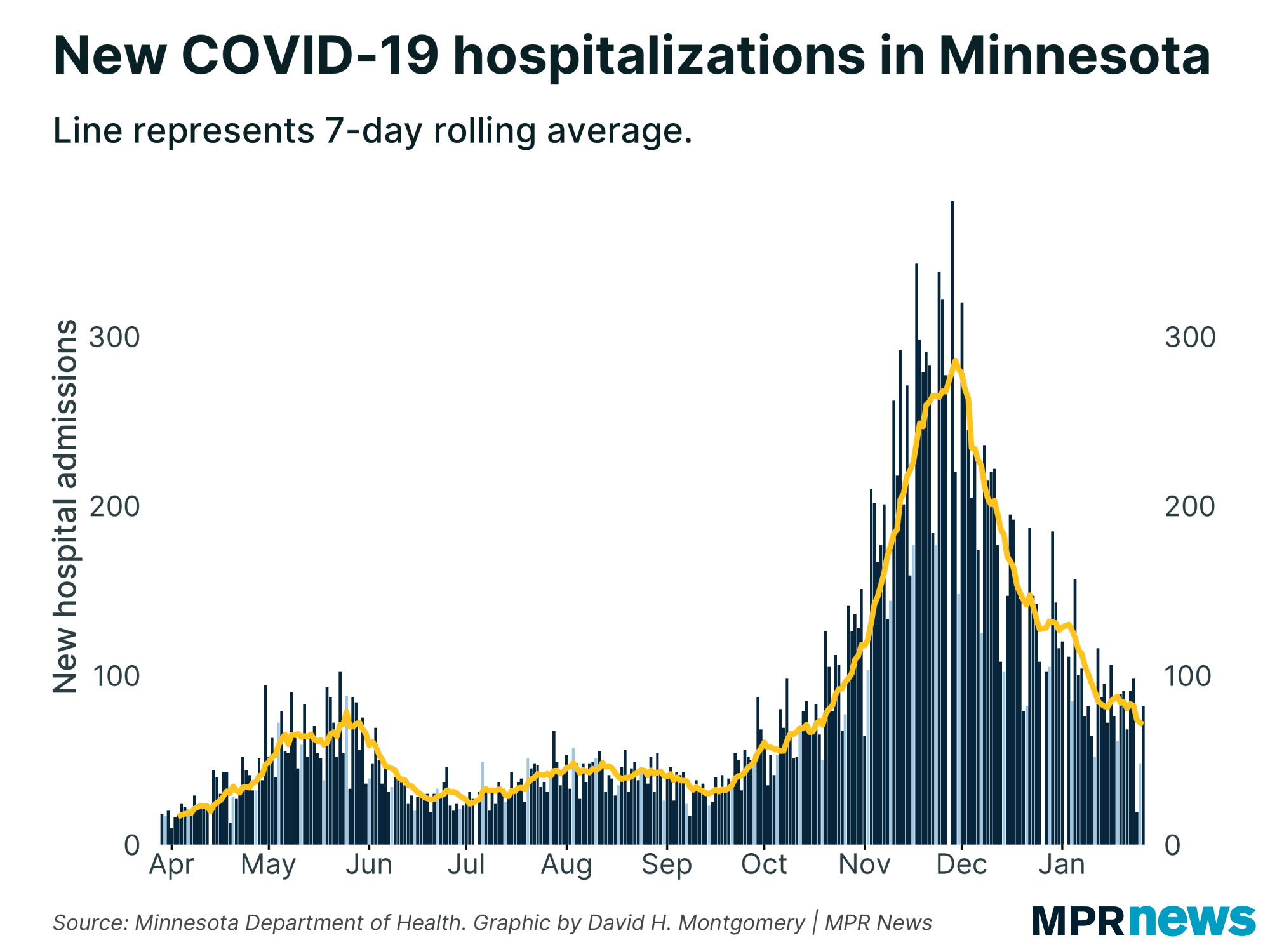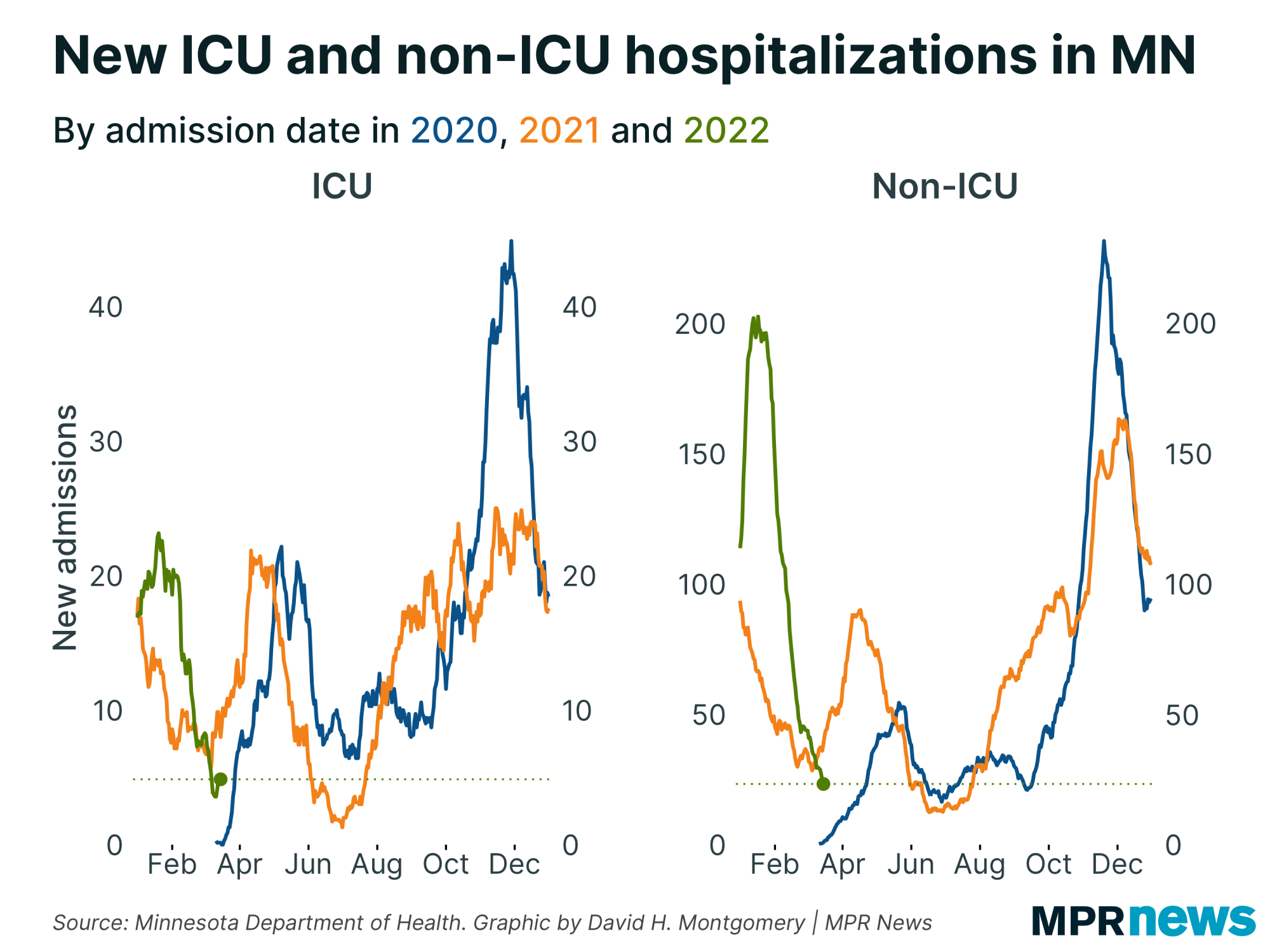Jan. 13 update on COVID-19 in MN: Moderate caseloads; hospital admissions down

Go Deeper.
Create an account or log in to save stories.
Like this?
Thanks for liking this story! We have added it to a list of your favorite stories.
Updated: 1:03 p.m.
Minnesota’s newest COVID-19 data shows the state staying steady on a path of relatively moderate growth in new cases as hospital admissions recede. State officials, though, still believe another surge is likely in the coming weeks following the year-end holidays.
The Health Department on Wednesday reported 1,504 newly confirmed or probable cases of the disease — along with 50 more deaths. That’s a higher death count then over the past week, but the overall trend remains down after a December spike.
Some 665 people were in the hospital with COVID-19 as of Tuesday, with 129 needing intensive care. Those counts have dropped by more than half over the past four weeks. The seven-day trend of new hospital admissions is down to levels not seen since late October.
Hospital admissions are now lower than Minnesota saw on Nov. 1, but still above their Oct. 1 level.
Turn Up Your Support
MPR News helps you turn down the noise and build shared understanding. Turn up your support for this public resource and keep trusted journalism accessible to all.

Even as they applaud the recent positive trends, health officials have been signaling that another upswing is expected. Wednesday’s data showed Minnesota’s count of active, confirmed cases ticking upward, although it’s still far lower than last month.

Gov. Tim Walz said in mid-December his COVID-19 watchers were worried about a February spike. On Monday, Health Commissioner Jan Malcolm braced Minnesotans to see daily death and case counts trending higher again.
“We do expect to see cases go back up in Minnesota following the year-end holidays, and potentially just as a result of the winter wearing on and more indoor time and more gatherings,” Malcolm told reporters.
Overall, Minnesota’s COVID-19 path remains hard to chart because of the reporting from those year-end holidays.
The cases reported Wednesday put Minnesota at 440,354 in the pandemic. Of those, about 95 percent have recovered to the point they no longer need to be isolated.

The newly reported deaths raised Minnesota’s toll to 5,774. Among those who’ve died, about 64 percent had been living in long-term care or assisted living facilities; most had underlying health problems.

Cases spread across age groups, regions
People in their 20s still make up the age bracket with the state’s largest number of confirmed cases — nearly 84,000 since the pandemic began, including more than 44,000 among people ages 20 to 24.

The number of high school-age youth confirmed with the disease has also grown, with more than 34,000 total cases among those ages 15 to 19 since the pandemic began.
Although less likely to feel the worst effects of the disease and end up hospitalized, experts worry youth and young adults will spread it to older relatives and members of other vulnerable populations.
It’s of particular concern because people can have the coronavirus and spread COVID-19 when they don’t have symptoms.
A relatively small bump in new cases has been happening across the state.

Hot spots continue to pop up in rural counties relative to their population.

Caseloads still heaviest among people of color
In Minnesota and across the country, COVID-19 has hit communities of color disproportionately hard in both cases and deaths. That’s been especially true for Minnesotans of Hispanic descent for much of the pandemic.

Even as new case counts ease from their late November, early December peaks, the data shows people of color continue to be hit hardest.
Distrust of the government, together with deeply rooted health and economic disparities, have hampered efforts to boost testing among communities of color, officials say, especially among unauthorized immigrants who fear their personal information may be used to deport them.
Similar trends have been seen among Minnesota’s Indigenous residents. Counts among Indigenous people jumped in October relative to population.
'A promise to deliver isn’t delivering'
Minnesota officials hope the federal government’s call for states to expand the priority pool of people getting COVID-19 vaccinations means more supplies are coming but they say the feds weren’t yet backing up those calls with more vaccine deliveries.
Trump administration officials Tuesday urged states to immediately expand eligibility to people 65 and older as well as people most vulnerable to the disease.
The administration also plans to start distributing vaccine based on a state’s over-65 population and its pace of vaccination. Currently, doses are allocated based on a state’s total adult population.
About 430,000 doses have been shipped to Minnesota so far to health providers and the federal program for long-term care facility vaccinations, according to the state’s new COVID-19 vaccination dashboard website; more than 150,000 Minnesotans have received at least one dose so far.
While Minnesota welcomes more vaccine becoming available more quickly to more people, “a promise to deliver isn’t delivering,” Kris Ehresmann, the state’s infectious disease director, told reporters Tuesday.
The changing federal recommendations could potentially add “a couple million people who will expect to be vaccinated” in Minnesota, she said. “If we’re only getting 60,000 doses a week, that is going to be a real problem.”
No additional doses have been shipped or arrived, she added.

“We are ready to receive more vaccine if the feds actually follow through on their promise,” Ehresmann said. Right now, “there are no additional doses for use. There are not doses to put into arms to go along with that.”
Later Tuesday, Gov. Tim Walz’s office said the U.S. Department of Health and Human Services had agreed to the requests of Minnesota and eight other states to release “millions of doses” that had been held back for distribution. The exact amount of supply that would go to Minnesota, though, wasn’t detailed.
Developments around the state
MN to remain in peacetime emergency for at least another 30 days
The state will remain in a peacetime emergency posture for at least another 30 days.
Gov. Tim Walz has extended his COVID-19 executive authority with approval of a council of state officeholders. The declaration he first issued last March has enabled his administration to manage the pandemic response. But it has also riled critics who say he should consult the Legislature more directly.
While there has been some recent improvement in coronavirus trends here, Health Commissioner Jan Malcolm said risks remain.
“The conditions remain very fragile and volatile. Certainly we could see and frankly expect to see continued increase in cases as economic activity and social interactions pick up a bit," Malcolm said.
— Brian Bakst | MPR News
Minnesota tweaks phone alert system that tracks COVID
Minnesota is making some changes to the phone alert system it uses to help track COVID-19.
The change applies to many users of Apple's iPhone. The state's information technology agency, MNIT, said this weekend that users with newer operating systems will get a prompt that allows them to turn on exposure notifications, without using the separate COVID-19 app. It's part of technology widely in use already, developed by Apple and Google, that can be incorporated into a phone's operating system.
The service has all the same features as the app, using Bluetooth technology and randomly assigned numbers to detect others in close proximity, and later share anonymously if either party reports a positive COVID-19 test. The new version, like the app itself, does not collect individual information or track locations.
— Tim Nelson | MPR News
Top headlines
Schools are poised to reopen, but teachers aren’t vaccinated: Teachers from some of the state’s largest school districts are voicing concerns about the return to in-person instruction, noting that they have yet to be vaccinated at a time when the COVID-19 virus is still spreading.
As Minn. rolls through first round of vaccinations, some providers worry about being left out: Minnesota is inching toward the last phase of its initial COVID-19 vaccinations. But providers, like residential substance abuse treatment centers and mental health providers, say they’re still in the dark about when and where their staff will get the vaccine.
Minnesotans with disabilities wonder when they'll get COVID-19 vaccine: As a group, people with disabilities often disproportionately suffer from the effects of the pandemic.
COVID-19 in Minnesota
Data in these graphs are based on the Minnesota Department of Health's cumulative totals released at 11 a.m. daily. You can find more detailed statistics on COVID-19 at the Health Department website.
Dear reader,
The trustworthy and factual news you find here at MPR News relies on the generosity of readers like you.
Your donation ensures that our journalism remains available to all, connecting communities and facilitating better conversations for everyone.
Will you make a gift today to help keep this trusted new source accessible to all?




